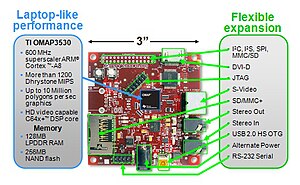This is an old revision of this page, as edited by 129.247.247.240 (talk) at 17:04, 4 November 2009 (→External links: -external link, see WP:EL). The present address (URL) is a permanent link to this revision, which may differ significantly from the current revision.
Revision as of 17:04, 4 November 2009 by 129.247.247.240 (talk) (→External links: -external link, see WP:EL)(diff) ← Previous revision | Latest revision (diff) | Newer revision → (diff)
The Beagle Board is a low-power, low-cost Single-board computer produced by Texas Instruments in association with Digi-Key, designed with open source development in mind, to demonstrate the Texas Instrument's OMAP3530 system-on-a-chip. The board was developed by a small team of TI engineers.
Features
The Beagle Board measures approximately 3" by 3" and has all the functionality of a basic computer. The OMAP3530 includes an ARM Cortex-A8 CPU (which can run Windows CE, Linux or Symbian), a TMS320C64x+ DSP for accelerated video and audio decoding, and an Imagination Technologies PowerVR SGX530 GPU to provide accelerated 2D and 3D rendering that supports OpenGL ES 2.0. Video out is provided through separate S-Video and HDMI connections. A single SD/MMC card slot supporting SDIO, a USB On-the-Go port, an RS-232 serial connection, a JTAG connection, and two stereo 3.5mm jacks for audio in/out are provided.
Built-in storage and memory is provided through a PoP chip that includes 256MB of NAND flash memory and 256MB of RAM (128MB on earlier models).
The board uses up to 2W of power and can be powered from either a USB connection, or a separate 5v power supply. Because of the efficient power consumption the board requires no additional cooling.
Specifications

- Package on Package POP CPU/Memory chip.
- Processor TI OMAP3530 Processor - 600MHz ARM Cortex-A8 core
- 'HD capable' TMS320C64x+ core (75MHz up to 720p @30fps)
- Imagination Technologies PowerVR SGX 2D/3D graphics processor supporting dual independent displays
- 256MB LPDDR RAM memory
- 256MB NAND Flash memory
- Peripheral connections
- DVI-D (HDMI connector chosen for size - maximum resolution is 1280x1024) , S-Video, USB OTG (mini AB), USB, SD/MMC card slot
- Stereo in and out jack plug sockets
- RS232 port
- JTAG connections
- Power socket (5V barrel connector type)
- Development
Similar products
- Pandora handheld game console that uses the same Texas Instruments OMAP3530 as the BeagleBoard.
- Gumstix overo uses the OMAP3503 and the OMAP3530 to provide a similar single-board computer package.
- OSWALD - developed by Oregon State University students for computer science education, uses the OMAP3530.
- EBVBeagle Board - Beagle Board clone from EBV Elektronik.
- Empower Technologies's EMP3503 and EMP3530 single-board computers running LEOs (RTOS)
- FOX Board - a complete Linux system in just 66 x 72 mm - Not OMAP3 based.
- IGEPv2 - A board that includes more RAM, built-in Bluetooth and Wi-Fi, a USB host, and an Ethernet jack.
See also
- Single-board computer
- Texas Instruments OMAP
- Texas Instruments TMS320
- OmapZoom
- OpenEmbedded
- Pandora
- hawkboard
References
- ^ $150 board sports Cortex-A8
- ^ "OMAP3530 Beagle Board" High performance and numerous expansion options:page 3
- "OMAP3530 Beagle Board" High performance and numerous expansion options:page 4
- "OMAP3530 Beagle Board" Boot Options: page 9
- Android On Beagle
- Linux-friendly Beagle fetches $150
- "Gentoo Pandora Project". Gentoo Pandora. Gentoo Pandora Devs. Retrieved 2009-05-27.
- TI launches hackable Beagle Board for hobbyist projects
- Beagle Board gets Windows CE support
- RISC OS Open Cortex-A8 port
- RISC OS 5 pictured running on ARM Cortex-A8 kit
- Beagleboard runs RISC OS 5 desktop
- RISC OS on OMAP - the future?
- RISC OS on new hardware
- Signage SBCs tap ARM Cortex-A8 SoCs
External links
- Beagleboard.org
- OMAP35x Applications Processors
- Texas Instruments OMAP Developer Network
- Google Code hosted Beagle Board code site
- elinux.org BeagleBoard wiki page
- Link to set of Beagle Board introductory videos (Youtube)
- PEEDI JTAG/BDM Emulator and Flash Programmer
Sources
- TI launches hackable Beagle Board for hobbyist projects
- TI Takes Wireless Chips into New Markets
- Beagle Board Product Training Module
- beagleboard.org
- Linux-friendly Beagle fetches $150